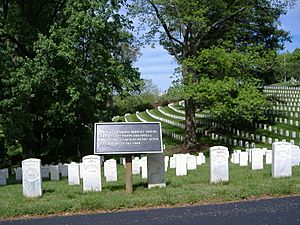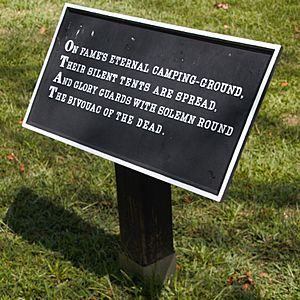Bivouac of the Dead facts for kids
"Bivouac of the Dead" is a famous poem written by Theodore O'Hara from Danville, Kentucky. He wrote it to honor his fellow soldiers from Kentucky who died fighting in the Mexican–American War. The poem became even more popular after the American Civil War. Its powerful words have been placed on many memorials for fallen soldiers, especially in the Southern United States. You can also find parts of it at Arlington National Cemetery, including its main entrance.
How the Poem Was Written
When the Mexican–American War started in May 1846, Theodore O'Hara left his job in Washington, D.C. He went back to Kentucky to join the army. Within a month, he became a Captain in the Kentucky Volunteers. He also worked as their assistant quartermaster, helping with supplies.
Before returning to Kentucky in 1847, he was promoted to a special rank called a brevet major. O'Hara wrote "Bivouac of the Dead" after hearing about the many soldiers from Kentucky who died in the Battle of Buena Vista. He wrote it to honor these brave fallen troops.
Many of the Kentuckian soldiers were buried at Frankfort Cemetery on July 20, 1847. A future Vice President, John C. Breckinridge, spoke at the event. People aren't sure if O'Hara read his poem that day, but it's a common belief. It is known that he did read the poem at the same cemetery in 1850. This was for the burial of William T. Barry and General Charles Scott.
"Bivouac of the Dead" was later called "a worthy contribution to American Literature." It was first printed in a newspaper called the Frankfort Yeoman in 1850. However, some historians think it might have been written in 1851. This would have been after a failed attempt by Narciso López to free Cuba from Spanish rule.
Theodore O'Hara sometimes changed the words to "Bivouac of the Dead." He would remove mentions of specific places or take out certain parts. In 1858, a newspaper called the Mobile Register printed what many believe was the original poem. Another newspaper, the Louisville Courier, also printed the original version. They said it was the one read at the 1847 ceremony. In 1900, The New York Times wrote an article saying that all the changes to the poem should stop. They wanted people to go back to the original version.
When O'Hara's body was moved to be buried again at Frankfort Cemetery, a friend used "Bivouac of the Dead" as a special speech to honor him.
Where the Poem Is Used Today

The very first memorial in Kentucky for soldiers of the Confederate States of America used a line from "Bivouac of the Dead." This was the Confederate Monument in Cynthiana. Six other memorials in Kentucky also use parts of the poem to honor fallen Confederate soldiers.
You can also find parts of the poem on 7 plaques at Finn's Point National Cemetery in Pennsville, New Jersey. Many Confederate soldiers who died while being held captive during the American Civil War are buried there.
A general named Montgomery C. Meigs chose to put "Bivouac of the Dead" at the entrance to Arlington National Cemetery. He liked its serious and respectful message. However, at Arlington and many other national cemeteries, O'Hara was not given credit for the poem. This was because he had fought for the Confederacy during the Civil War.
The Governor of Wisconsin, Lucius Fairchild, lost an arm fighting for the Union side at the Battle of Gettysburg. He quoted the last part of the poem when he dedicated a monument for soldiers in Grant County, Wisconsin, on July 4, 1867.
In the late 1920s and 1930s, some lines from the poem were removed from markers in national cemeteries. Only fourteen cemeteries were left with verses from "Bivouac of the Dead." But in 2001, the National Cemetery Administration started putting the first part of the poem back in any national cemetery where it was missing.
You can find parts of the poem at Marye's Heights in Fredericksburg, Virginia. Also, Antietam National Cemetery in Sharpsburg, Maryland, and Winchester National Cemetery in Winchester, Virginia, have phrases from the poem on markers in different spots.



